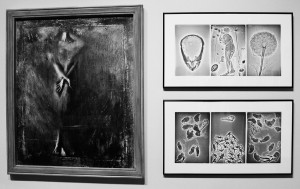Sight Specific highlights LA photography
As you walk up the steps of the Fisher Museum of Art, a glass door provides a backdrop for four large gray words spelling out “L.A. is 18% GRAY.”

Vision · Fisher Museum features progressive artwork, such as Judy Coleman’s “Crossed Hands” (left) and Sheila Pinkel’s two untitled works (right), in its ongoing exhibition Sight Specific: LACPS and the Politics of Community. - Eddie Kim | Daily Trojan
Because it hardly rains in Los Angeles, the statement hits the nail on the head. These curious words, however, refer not to the bipolar weather of the city, but to the idea of using an 18 percent gray card, a photographer’s tool to capture a specific amount of light. Emblazoned on a T-shirt, the phrase became the motto for the Los Angeles Center for Photographic Studies, an organization started in 1974 to inspire photographic creativity and a sense of community.
Inside the walls of the Fisher Museum, decades later with the advent of new photographic technology, lies the history of the organization and photography as an art form.
Sight Specific: LACPS and the Politics of Community houses works from various shows put on by LACPS. As part of the Getty’s expansive Pacific Standard Time initiative, an effort to establish Los Angeles as a veritable art center in the post-World War II era, Sight Specific sheds light on a lost part of L.A. photography with works from 1974 to 1985. Planning began when the Getty awarded a grant to USC to take part in PST.
Curated by Tim Wride, the current William and Sarah Ross Soter curator of photographs at the Norton Museum of Art in Florida and formerly the Curator of Photography at LACMA, the show organizes specific sections set off by themes or individual artists, each with a clipboard and a piece of paper stating where and when the show took place. The show also presents binders that visitors can leaf through, along with relevant magazines and books.
Wride attempted to take a different approach to curating than that of other PST shows.
“Often what happens in PST is that there is a lot of recontextualizing of work that we know or work we thought we knew and it’s a lot of the same people in the same shows, just with a different edge to them,” Wride said. “What I was hoping to do was put together a show that concentrated first on the works of art and allowed their context then to actually manifest so that the ideas they were grappling with [would] become forefront.”
The show’s unique location on a college campus also creates a new dynamic, which Wride and Fisher Museum Director Selma Holo recognize. The exhibition specifically interacts with USC by going hand in hand with various programs, including an upcoming poetry reading titled A Sight-Specific Poetry Reading.
“This exhibition has to have its own integrity as well as being part of a bigger web,” Holo said. “Because it’s at a university, it’s important that we have not only the objects on the wall and the text panels. The programs we have that accompany this show are very important for the students.”
Yet someone on campus who stumbles across the show, unaware of PST, can still appreciate the exhibition.
“As a curator, I always believe there are so many multiple access points to work that you put on the wall and one of my jobs is to keep all of those access points as open as possible,” Wride said. “For the USC students and faculty audience, it was my intent to provide a glance into issues of the ’70s that are still affecting art-making today.”
The amount of materials in the show might overwhelm a casual visitor at first, but the issues presented remain significant.
“There are issues of race, social class, marginalized groups and just what is art, that are raised and, to some extent, answered in the exhibition,” Holo said.
Wride explained that until the late 1930s and the explosion of intellectual conversation and collectors, photography wasn’t truly accepted as an art form.
“As soon as photography generally was more accepted, LACPS laid all the groundwork in Los Angeles,” Wride said. “It had created an infrastructure for photography, it created community, it broached philosophical and intellectual issues that made photography as art relevant.”
Even if a visitor doesn’t recognize any of the names associated with the photographs, the works exist as humorous, thought-provoking and technically adventurous documents of a bygone era.
The large spectrum of aesthetic style proves initially daunting, but ultimately impressive. Bonnie Gordon’s pieces present intriguing mixtures between words and images, as are Barbara DeGenevieve’s humorous works. Additionally, photographs like Todd Gray’s explore the presentation of landscapes, while Marion Palfi’s heart-wrenching images touch on the issue of poverty.
In the end, the exhibition provides a rare historical look at an important organization and plenty of inspiration for any new and emerging artists. The floor of the Fisher Museum reflects the blurred images of all the pieces hanging on the wall, possibly waiting to be walked on by the next great artists to make a splash in the world of photography.
Sight Specific: LACPS and the Politics of Community runs through April 7.

Comments are closed.